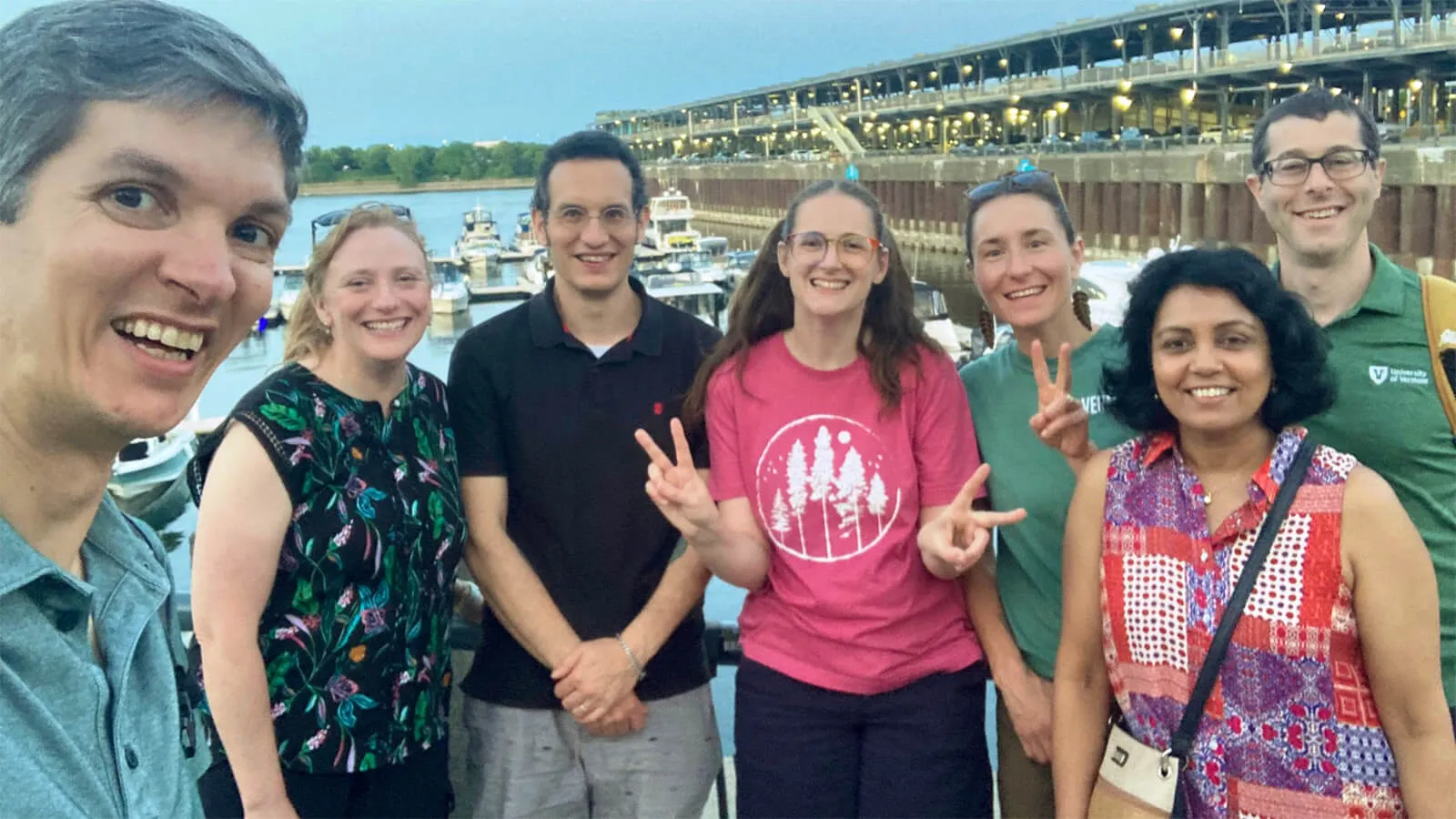This month, the College of Engineering and Mathematical Sciences sent its largest ever contingent to the annual American Society for Engineering Education (ASEE) conference. Held across our northern border in Montreal, the conference featured several CEMS faculty presentations and a UVM-hosted workshop. The group returned to campus with a pair of notable awards for their innovative work to support, study, and improve engineering education.
The ASEE conference is the nation’s largest gathering of engineering educators and highlights the pioneering work being done around the country to improve access, pedagogy, and curriculum for all engineering disciplines. Initially founded as the Society for the Promotion of Engineering Education (SPEE) in 1893, ASEE has grown to advance innovation, excellence, and access at all levels of education for the engineering profession.
This year’s attendees included Courtney D. Giles, Priyantha Wijesinghe, Matt Scarborough, and John Lens from Civil and Environmental Engineering, David Jangraw from Biomedical Engineering, Larry Medsker from Physics; Eva Cosoroaba from Electrical and Computer Engineering, Keith Epstein from Mechanical Engineering, and Holly Buckland Parker from the UVM Center for Teaching and Learning.
Conference workshop
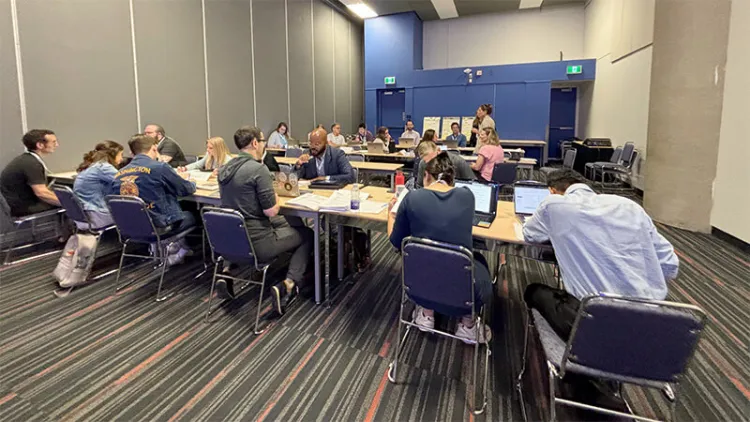
Attendees from 20 different colleges and universities attended the UVM-led workshop: Working with Learning Maps to (Re)Design Course Sequences. Courtney D Giles, Priyantha Wijesinghe, Larry R Medsker, and Holly Buckland Parker introduced participants to their process for designing course sequences as developed through the National Science Foundation(NSF)-funded Learning Map Research Project, which seeks to improve student learning and knowledge transfer through the intentional and collaborative design of STEM course sequences.
The facilitators shared their two-pronged approach to help faculty identify key areas for improvement within and across their course sequence: (1) Faculty reflection on curricular bottlenecks and historical barriers to student learning, and (2) the development and use of visual “Learning Maps” to aid in the identification of key learning outcomes, concepts, and skills that must be carefully introduced and cultivated throughout the curriculum. Participants then had the opportunity to choose from one of two interactive breakout sessions to help instructors identify key areas for improvement and to intentionally align learning outcomes, assessments, and instruction across a sequence.
Presentations
During the four-day conference, several CEMS faculty members shared presentations on both posters and papers:
—Dr. Priyantha Wijesinghe, Dr. Holly Ann Buckland Parker, and Ethan Zachary Stein
In this case study, the team of UVM researchers explored the integration of Generative AI (GenAI)-based writing assignments into a senior-level civil engineering design course. The goals of the study were to cultivate a culture of AI among students, enable them to critically evaluate the GenAI outputs and their limitations, and to assess and discuss the ethical use of AI within the civil engineering profession. Twenty-seven students participated in the two writing assignments: one requiring the use of AI and the other permitting its optional use. The results of a qualitative analysis of students' responses indicated common themes regarding their perceptions of GenAI use both in learning and in engineering professions, including the balance between AI-assisted creativity as well as concerns about the reliability of AI-generated information.
We believe the forward-thinking approach to GenAI in engineering education can foster an innovative learning environment favorable to experimentation with these tools. The insights gained from this case study highlight the importance of integrating GenAI into the civil engineering curriculum. Dr. Wijesinghe and her colleagues hope that providing such opportunities in the engineering classroom will help prepare students to use GenAI responsibly and effectively in their profession upon graduation.
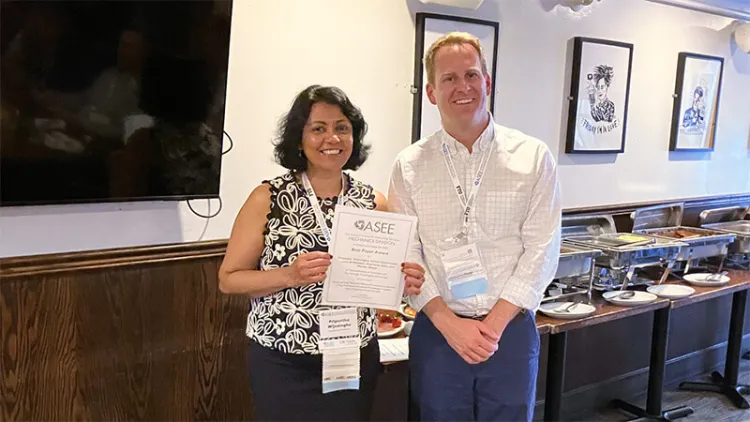
—Dr. Priyantha Wijesinghe, Dr. Varuni A. Seneviratne, Dr. Larry R. Medsker, Dr. Courtney D. Giles, and Civil Engineering senior Marlee Ottati.
This paper, which took the conference’s top honor as best paper in the Mechanics Division, presents the design and analysis of a pilot problem set deployed to engineering students to assess their retention of physics knowledge at the start of a statics course. Using a problem set developed during the National Science Foundation (NSF)-funded Learning Map Research Project to better evaluate students' understanding and retention of physics concepts at the beginning of a statics course. The problems required students to perform calculations, demonstrate their work, and assess their conceptual understanding of key topics, and allowed instructors to assess essential prerequisite skills. The problem set used the revised 2D Bloom’s Taxonomy and a 3D representation of it to classify each problem within a 6x4 matrix (six cognitive processes x four knowledge dimensions). This classification provided instructors and students with a clear understanding of the cognitive level required for each problem. The resulting analysis will inform future efforts to evaluate knowledge retention and transfer in key skills across sequential courses.
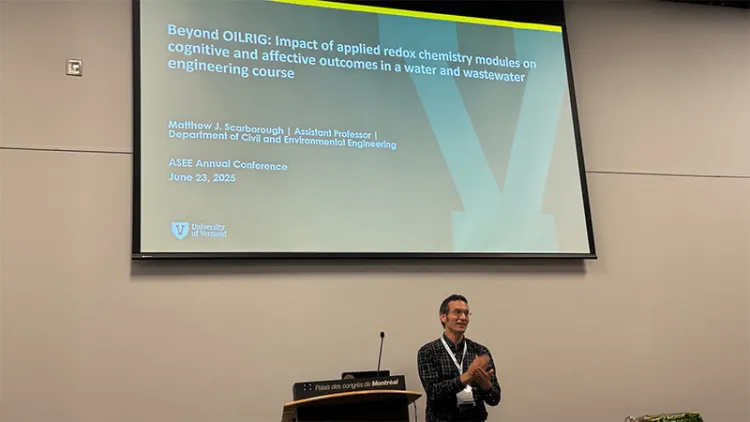
—Dr. Matthew J. Scarborough
Dr. Scarborough’s paper explored pedagogical shifts to improve chemistry knowledge and skills as applied during a water and wastewater engineering course. Using three-years of pre-course survey responses, Dr. Scarborough found that civil engineering (CivE) and environmental engineering (EnvE) majors at the University of Vermont lack confidence in applying chemistry to solve engineering problems. As part of the resulting curricular changes—including adding in two modules on redox chemistry— will improve both affective and cognitive chemistry outcomes in a water and wastewater engineering course. This study was supported by CEMS Scholarship of Teaching of Learning (SoTL) funds.
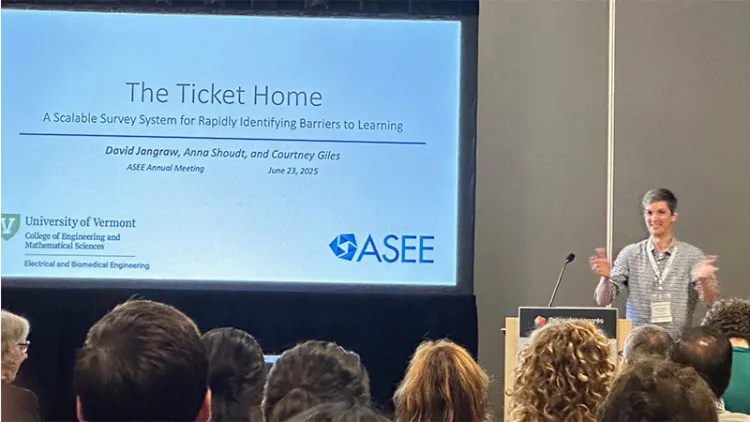
The “Ticket Home”: A Scalable Survey System for Rapidly Identifying Barriers to Learning
—Dr. David Jangraw, Biomedical Engineering senior Anneliese Marie Shoudt, and Dr. Courtney D. Giles
In their Empirical Research Paper, the team from UVM presents a large-scale weekly student feedback system that identifies barriers to learning and “muddiest points”. Designed to promote inclusive teaching, the barriers tend to be more prevalent/severe in students with disabilities, financial disadvantages, or mental health conditions, and students from underrepresented groups are typically more reluctant to raise concerns unprompted. Their pilot program uses a centralized support system to minimize instructor time commitment and holds promise as a model for other initiatives to scale up evidence-based teaching interventions. Prior to leaving class, students complete a brief online survey as their “Ticket Home,” exploring conceptual understanding, preferences, and opportunities to improve. 9 instructors of 11 classes in 5 departments, teaching 422 students, used the Ticket Home system in Fall 2024. The online surveys resulted in 2,739 Ticket Home responses to 101 class sessions. Student Ticket Home responses most often requested examples and practice, slower paces and more breaks, more guidance on assignments, and more active learning exercises. Moving forward, the researchers hope to expand the Ticket Home program to generate broader results to better inform future offerings of the Ticket Home and other scalable teaching interventions.
Awards
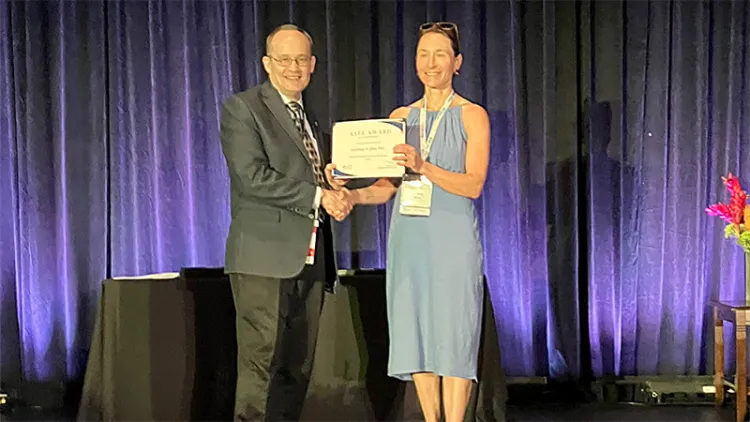
As well as receiving the award for Best Paper in the Mechanics Division (See above: Using Learning Maps and Bloom’s Taxonomy to Develop a New Instrument to Assess Knowledge Transfer from Physics to Statics Courses), Associate Dean for Academic Affairs Courtney D Giles was awarded as the “Outstanding Campus Representative” for Zone I in New England.
